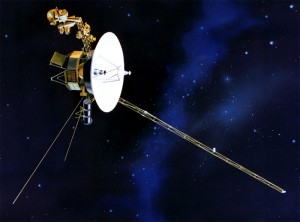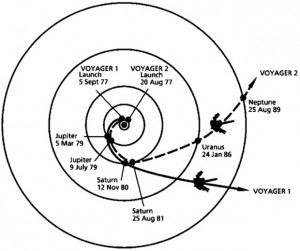This post was originally written for my first blog, posted on 12/12/2007. It’s a goofy little post I wrote because the Voyager spacecraft are generally awesome and I’m a huge nerd. OK, that and there was a pretty major milestone passed. I’m reposting now because 25 years ago today, Voyager 2 made its 4.19 radii pass of Uranus (pffft). I know it’s pretty far from SQL Server, but, huge nerd and the Voyagers are awesome.
Images Courtesy NASA/JPL-Caltech
I sort of missed the boat on this when it happened, but back on August 20, Voyager 2 marked its 30th year in space. For 30 years, that little chunk (and its cohort, Voyager 1) has been hurtling through space, measuring plasma levels, temperatures, and taking pictures of crap, among other things.
Thirty. Years.
To me, the Voyagers are some of the most memorable and recognizable pieces of equipment that NASA has ever thrown up in the air. I remember 2’s flyby of Neptune in 1989 (map of the planetary flybys is below), and it was one of the targets of my early obsessions with all things aerospace. Sure, the space shuttle was a little more visible, but there was always something special about Voyager.
And here it is, a spacecraft built to run for five years, still going strong after six times that. I guess they don’t make them like they used to, but then again, the Mars Rovers are still going after, what, almost four years now, and they were supposed to go for 30 days? I joke a lot about how we sent men to the moon with chalkboards and slide rules, but man, those Engineers can do anything with just about anything. I mean, NASA did put a square peg in a round hole, once…
Anyway, Voyager 2 has now reached the edge of the Solar Wind. That’s way out there. Even though I haven’t a clue what most of what you learn from that is about or how it is useful (that’s more of my sister’s area), it’s still pretty cool. I’ve never really thought about the dynamics of the SW on the interstellar gas; I suppose that could be due to how I just thought of the gas as just there, not necessarily an entity that would interact with things within it. This is why I’m in IT and not working at the JPL or something 😉
I can’t help but think about how I zip around far greater patches of space in my little Internet Spaceships in seconds and it’s taken these guys 30 years to get to where they’re at now. I know it’s just a stupid game, but I still believe that someday our technology will have us there, too. I don’t expect to be around to see it of course, but there will be some dreamer like me there to take advantage of it.











